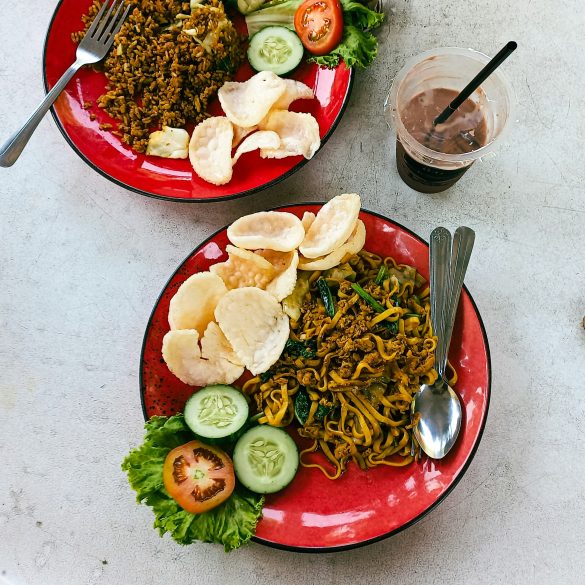Vietnamese Food Guide: Authentic Flavors & Traditional Recipes
Walking through the bustling streets of Ho Chi Minh City three years ago, I was absolutely mesmerized by the incredible aromas wafting from every corner food stall. Honestly, nothing could have prepared me for the complexity and depth of Vietnamese cuisine1. What struck me most wasn’t just the incredible flavors—it was how each dish told a story of Vietnam’s rich history, geographic diversity, and cultural evolution.
Vietnamese food represents one of the world’s most sophisticated culinary traditions, yet it remains surprisingly accessible to home cooks. The cuisine masterfully balances five fundamental elements: spicy, sour, bitter, salty, and sweet2. This approach creates dishes that are both nutritionally balanced and incredibly satisfying. From my experience cooking Vietnamese food for the past five years, I’ve learned that success comes from understanding these fundamental principles rather than following rigid recipes.
Vietnam Food Culture Insight
Vietnam’s cuisine varies dramatically across three distinct regions—North, Central, and South—each developing unique flavors based on climate, geography, and historical influences. Northern cuisine tends toward subtle, balanced flavors, while Southern dishes embrace bold, sweet elements influenced by Cambodia and Thailand.
What really excites me about Vietnamese cooking is how it prioritizes fresh ingredients and healthy preparation methods. Most dishes are steamed, grilled, or quickly stir-fried—techniques that preserve nutrients while creating incredible flavors3. Actually, let me clarify that—the health benefits aren’t just coincidental. Vietnamese cuisine evolved around principles of balancing hot and cold foods, creating meals that support overall wellness.
Before we dive deeper into specific dishes and techniques, I want to address something that initially intimidated me about Vietnamese cooking—the ingredient list. Many recipes call for ingredients that might seem exotic or hard to find. Here’s what I’ve learned: while authentic ingredients definitely enhance the experience, Vietnamese cuisine is incredibly adaptable. The core principles of fresh herbs, balanced flavors, and simple preparation techniques can be applied using ingredients available in most supermarkets.
Essential Vietnamese Dishes & Core Ingredients
Let’s start with the dish that absolutely changed my perspective on Vietnamese cuisine—pho. When I first attempted making pho at home, I completely underestimated the complexity of the broth. The secret isn’t just the bones and spices; it’s the patience4. Authentic pho broth requires 12-24 hours of slow simmering, allowing the bones to release their collagen and the spices to develop deep, complex flavors.
The Pho Foundation
Pho represents the soul of Vietnamese cuisine—a perfect harmony of aromatic broth, fresh herbs, and quality protein. The broth combines beef or chicken bones with star anise, cinnamon, cardamom, and cloves, creating a foundation that’s both comforting and energizing.
Beyond pho, Vietnamese cuisine offers incredible diversity. Banh mi showcases the country’s French colonial influence, combining crusty baguettes with distinctly Vietnamese flavors5. What I love about banh mi is how it represents cultural fusion at its finest—Vietnamese pickled vegetables, cilantro, and protein nestled in French bread, creating something entirely new and delicious.
| Essential Ingredient | Flavor Profile | Common Uses | Substitution Options |
|---|---|---|---|
| Fish Sauce (Nuoc Mam) | Salty, umami-rich | Marinades, dipping sauces | Soy sauce + anchovies |
| Lemongrass | Citrusy, aromatic | Soups, marinades | Lemon zest + ginger |
| Vietnamese Mint | Spicy, cooling | Fresh garnish, salads | Regular mint + basil |
| Rice Paper | Neutral, chewy | Spring rolls, wraps | Lettuce leaves |
Spring rolls—both fresh and fried—deserve special mention because they perfectly demonstrate Vietnamese cuisine’s emphasis on texture and freshness6. Fresh spring rolls (goi cuon) showcase raw vegetables, herbs, and protein wrapped in translucent rice paper. The beauty lies in their simplicity and the way each ingredient maintains its distinct character while contributing to the overall harmony.
“Vietnamese cuisine is not just about feeding the body; it’s about nourishing the soul through fresh ingredients, balanced flavors, and mindful preparation.”
From my years of experimenting with Vietnamese cooking, I’ve discovered that the herb selection makes an enormous difference. Vietnamese cuisine uses specific herbs that create unique flavor profiles—Vietnamese mint (rau ram), perilla leaves, and various types of basil each contribute distinctive tastes7. While substitutions work, seeking out authentic herbs from Asian markets elevates the authenticity significantly.

Traditional Cooking Techniques & Cultural Significance
Here’s where Vietnamese cuisine really shows its sophistication—the cooking techniques are deceptively simple yet require genuine skill to master. Take stir-frying, for example. Vietnamese stir-frying isn’t just about high heat and quick cooking; it’s about understanding the precise timing for each ingredient8. I learned this the hard way when my first attempts at Vietnamese stir-fries turned into soggy messes because I added everything simultaneously.
The concept of “wok hei”—the breath of the wok—applies beautifully to Vietnamese cooking. This refers to the distinctive smoky flavor that comes from proper high-heat cooking techniques. Actually, thinking about it differently, Vietnamese cooks achieve similar results using traditional clay pots and proper heat control, creating that essential “fired” flavor without necessarily using a wok.
- Steaming: Preserves nutrients while maintaining delicate textures
- Grilling: Creates smoky depth, especially important for proteins
- Quick blanching: Maintains vegetable crispness and vibrant colors
- Clay pot cooking: Develops complex flavors through slow, even heat
- Fresh preparation: Many dishes require no cooking at all
What really strikes me about Vietnamese cooking philosophy is the emphasis on balance—not just flavor balance, but nutritional and even spiritual balance9. Traditional Vietnamese meals include cooling and warming foods, designed to maintain bodily harmony. This isn’t just folk wisdom; modern nutritional science confirms that Vietnamese cuisine naturally provides excellent nutritional balance.
Regional Flavor Profiles
Northern Vietnam: Subtle, balanced flavors with emphasis on freshness and purity. Less sugar, more herbs and vegetables.
Central Vietnam: Bold, spicy flavors with complex spice blends. Imperial influences create sophisticated presentations.
Southern Vietnam: Sweet, rich flavors with coconut milk and palm sugar. Influenced by Cambodian and Thai cuisines.
The cultural significance of Vietnamese food extends far beyond nutrition. Sharing meals represents family unity and cultural continuity10. During my time learning from Vietnamese families, I observed how meal preparation becomes a communal activity—multiple generations working together, sharing techniques and stories. This social aspect of cooking and eating reinforces cultural bonds and passes down traditional knowledge.
“Every Vietnamese dish tells a story of adaptation, survival, and cultural pride. The cuisine reflects our history while embracing innovation.”
Rice, obviously, forms the foundation of Vietnamese cuisine, but the preparation methods vary significantly across regions and occasions11. Steamed rice serves as the neutral base for most meals, but Vietnamese cooks also create rice papers, rice noodles, and rice flour for various applications. Understanding rice’s versatility is crucial for appreciating Vietnamese cuisine’s complexity.
- Master basic rice preparation—perfectly steamed rice supports every meal
- Learn proper herb preparation—fresh herbs require gentle handling
- Understand sauce balance—sweet, sour, salty, spicy harmony
- Practice knife skills—Vietnamese cuisine requires precise, uniform cuts
- Develop timing sense—many dishes require last-minute assembly
Modern Vietnamese Cuisine & Global Influence
Vietnamese cuisine has experienced incredible global recognition over the past decade, and honestly, it’s about time12. What excites me most about this trend is how Vietnamese-American chefs are innovating while respecting traditional foundations. They’re creating dishes that honor their heritage while appealing to contemporary palates and dietary preferences.
The rise of plant-based Vietnamese cuisine particularly impresses me. Traditional Vietnamese cooking already emphasized vegetables and fresh ingredients, making the transition to vegetarian and vegan options relatively natural13. Buddhist temple cuisine in Vietnam has maintained sophisticated vegetarian traditions for centuries, providing authentic foundations for modern plant-based innovations.
Looking ahead, I believe Vietnamese cuisine will continue expanding globally while maintaining its essential character. The emphasis on fresh ingredients, balanced nutrition, and sustainable cooking methods aligns perfectly with contemporary food trends14. Plus, the cuisine’s natural gluten-free and dairy-free qualities make it accessible to people with various dietary restrictions.
“Vietnamese cuisine teaches us that sophistication doesn’t require complexity—sometimes the most profound flavors come from the simplest, freshest ingredients prepared with care and understanding.”
For home cooks interested in exploring Vietnamese cuisine, I recommend starting with simple dishes like fresh spring rolls or basic pho. Don’t worry about perfection initially—focus on understanding the flavor principles and ingredient interactions. Vietnamese cooking rewards patience and practice, but the journey is incredibly rewarding.
Essential Tips for Vietnamese Cooking Success
- Invest in quality fish sauce—it’s the foundation of Vietnamese flavors
- Find an Asian grocery store for authentic ingredients
- Start with simple dishes and build complexity gradually
- Focus on fresh herbs and vegetables for authentic taste
- Don’t be afraid to adjust seasonings to your preference
Vietnamese cuisine offers something truly special—a perfect balance of health, flavor, and cultural richness that enriches both body and soul. Whether you’re seeking nutritious meal options, exploring new flavors, or connecting with Vietnamese culture, this incredible cuisine provides endless opportunities for discovery and enjoyment15.



